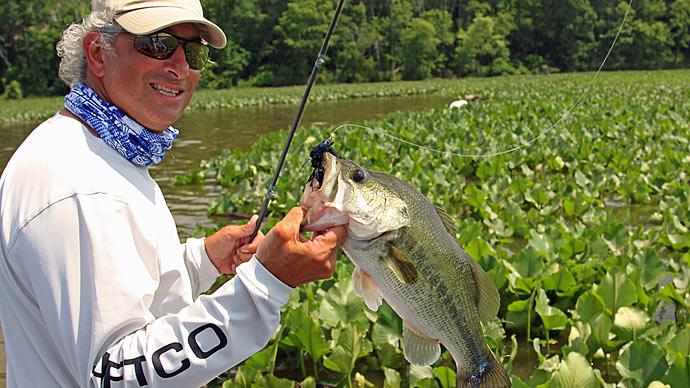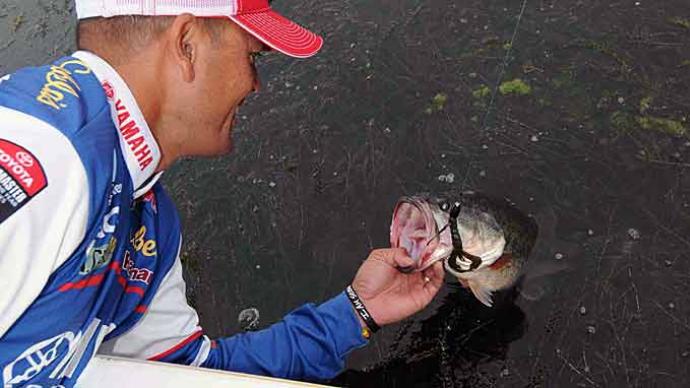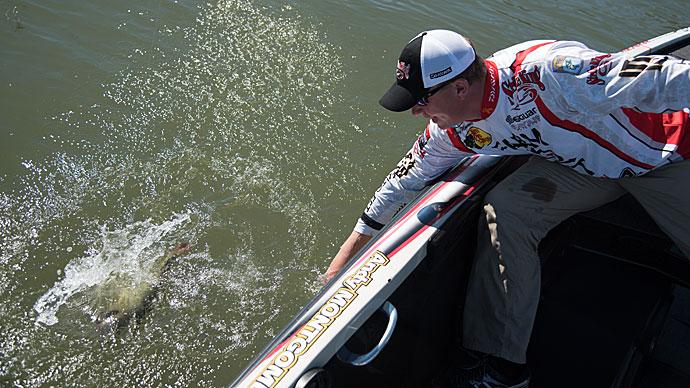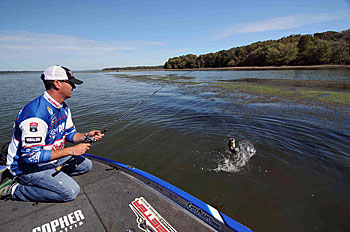
Todd Faircloth looks for bass in the grass during the dog days of summer and the hot weather of early fall.
The Bassmaster Elite Series pro knows matted vegetation is ideal cover for bass during this time because “it provides shade with a canopy and is a cooler place for bass to hide.” The aquatic vegetation also attracts shad and bluegill, primary food sources for bass.
Faircloth’s favorite matted vegetation for catching bass in late summer and early fall is hydrilla. “It grows the thickest and provides more of a shade canopy than any other grass, especially when it mats out,” he says.
The Texas pro rates milfoil and coontail as good grasses to fish in late summer/early fall. “Usually, the lake I am fishing with weeds in it will have one dominant grass,” he says. “Whatever that dominant grass is, that is what I will fish.” He notes fishing the weeds is even better if you find spots with a mixture of two types of grass.
Some spots contain hundreds of yards of matted vegetation, so finding the hot spots of the weeds is the key to catching more bass. “I always tell people when I am fishing weeds that bass follow the bottom contours of the lake, and they use the weeds as cover,” Faircloth says. “So I still want to fish points, channel swing banks, and an intersection of a creek or drain. I want to fish something different within that weedline.”
Other grass hot spots include a bald spot in the weeds, which could indicate a hump or rocks and logs sticking out of the vegetation. ”Anything different like that is a high percentage spot,” he says.
Faircloth notices schools of bass can be found on the weed points or holes in the grass, but the best spots to find heavyweight bass is in the isolated grass. “A real giant bass is going to be on something kind of isolated, like an isolated mat, isolated rock within that grass, or an isolated log in that grass,” he says. During the 2017 Bassmaster Elite Series event at Lake Champlain, he recalls catching a 6-pound, 1-ounce largemouth from an isolated weed mat.
Lakes usually draw down in late summer and fall, so Faircloth concentrates on the outer, deeper weedlines to catch bass in the grass. He favors keying on main lake vegetation throughout the summer but switches to weeds on the flats in creeks when the water starts cooling off in the fall.
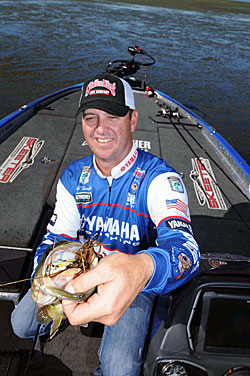
Sunshine with a light wind is Faircloth’s favorite weather for fishing grass because it positions bass in more specific places (spots with the most shade). He believes bass tend to roam around too much in the grass during cloudy, rainy days.
Faircloth’s top choice for weed fishing in the late summer is a Texas-rigged plastic worm. He favors a Strike King Rage Tail Cut-R Worm (red bug hue on southern waters and green pumpkin on northern lakes) that he rigs with a 1/4 or 3/8-ounce slip sinker and a 3/0 round bend offset hook. The tournament veteran casts the worm to the outside edges of the grass. “A lot of the bites will come on the fall, but then I will hop it back to the boat (after the initial fall),” he says.
Faircloth works the worm back to the boat with a lift-and-drop retrieve. He notices the worm's tail generates a subtle action that triggers strikes when he hops it over the outside clumps of grass. “I like to do that early in the morning and late in the evening when the fish are more towards the outside edge and are not buried up in the grass,” he says.
Punching the mats with a heavy weight and soft plastic bait is another productive tactic for late summer bass in the grass. “In the middle of the day, the fish will get buried up in that stuff, and I will take a Strike King Slither Rig in 1 ounce to 1 1/4 ounce and punch the mats,” Faircloth says.
His favorite soft plastic to combine with the Slither Rig is a Strike King Menace Grub attached to a 3/0 straight shank flipping hook. He combines a black-and-blue Slither Rig weight with a green pumpkin Menace Grub to imitate the bluegill colors in the vegetation.
Faircloth estimates that 80 percent of the strikes from bass in the grass occur on the fall after the rig has punched through the mat. “I am just punching it through, and once it goes through, I will hop it up two or three times, but he says I am not spending a lot of time in one spot,” he says.
The five-time B.A.S.S. winner looks for something different in the weedline for punching the Slither Rig through the mat. He keys on patches of mixed grass, the cheesy substance on top of hydrilla, or objects that have blown into the grass.
Early fall signals the beginning of frog fishing in the weed mats. “When the water starts cooling off, the fish will start feeding up for winter, and that is when I pick up the frog,” Faircloth says. “You will start seeing surface activity and hearing some bream popping in the grass beds.”
Faircloth opts for the Strike King KVD Sexy Frog in white, black, or brown when fishing the thickest mats. He prefers the Strike King KVD Popping Perch, a concave frog-style bait, for walking through sparse weeds or mats with large holes.
The Sexy Frog produces best for Faircloth when he skims it across the mat at a fast pace and then slows it down or stops it when the frog lands in a hole in the grass. He retrieves the Popping Perch at a medium pace when walking it along the sparse weeds.
Faircloth’s tackle for worm fishing the weed edges consists of a 7-foot medium-heavy CastAway rod and Shimano 7.4:1 Metanium MGL baitcast reel with 14- to 16-pound Sunline Super FC Sniper Fluorocarbon. He punches the mat with a 7 1/2-foot Castaway rod and Shimano Metanium reel filled with 50-pound Sunline Braid. Faircloth's picks for frog fishing are a 7-3 Castaway Big T’s Triple Threat rod combined with a Shimano Metanium reel and 50-pound Sunline Braid.
BassResource may receive a portion of revenues if you make a purchase using a link above.


